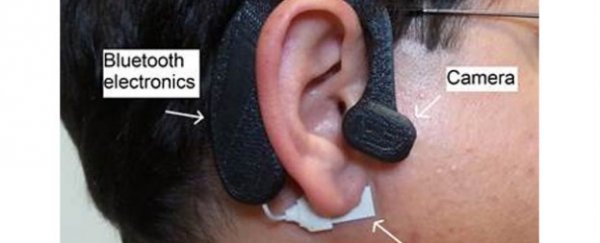Many people use health-tracking apps to automatically monitor and calculate how many calories they have burned throughout the day. While these are great for people who are trying to improve their diet, they rely on the user to enter their eating habits manually - and let's be honest, even with the best intentions, it's very easy to simply forget or accidentally provide inaccurate estimates of food intake.
In an effort to make the process of health-tracking more user-friendly, researchers from the University of Alabama in the US have come up with a sensor that automatically tracks a person's diet based on their chewing motions.
"Eating may be an unconscious, even automatic behaviour for some individuals, and the literature is full of examples of dietary behaviours which increase the risk for overeating," said Edward Sazonov, engineer and one of the team, in a press release.
The sensor, called an Automatic Ingestion Monitor (AIM), fits around one of the user's ear and monitors the vibrations in their jaw, as they chew while filtering out other jaw motions, such as talking and yawning. AIM is also fitted with tiny cameras that capture images of the food as it enters the user's mouth.
The food is identified when the images are automatically compared to an online database, which can provide information about its calorie content, nutrients, mass, and energy of the meal. This ensures that users and their doctors are working with accurate diet information, which can often be skewed by self-reporting.
"We can estimate diet and nutrient intake, but the primary method is self-reporting. The sensor could provide objective data, helping us better understand patterns of food intake associated with obesity and eating disorders," said Sazonov in the release.
The team has been awarded a $1.8 million five-year grant from the National Institute of Health in the US to test the accuracy of AIM in diet-tracking through several large-scale experiments.
Currently, doctors use a drink known as doubly labelled water to track energy use in the body. This method measures how fast the body can expel added isotopes of hydrogen and oxygen. After two weeks, the information gives an estimate of how many calories a person has consumed. While this technology is accurate, it's expensive and doesn't track eating behaviour. The team plans to test the accuracy of AIM against the doubly labelled water method, and if both methods' accuracy is on par, they will be able to offer a cheaper diet-tracker than what's currently available.
Initially the device will be designed for medical use, but in time, Savonoz hopes to make it available to all consumers wanting to keep track of their diet. Doctors could use the data collected by AIM to create individualised weight-loss strategies for patients, and also to help those with eating disorders.
Source: The University of Alabama
